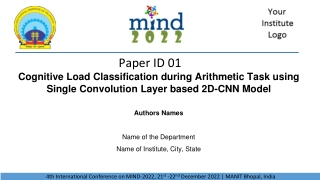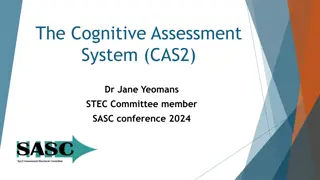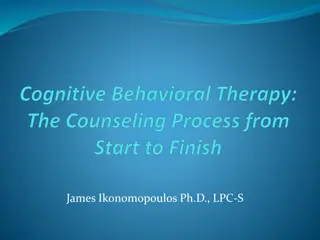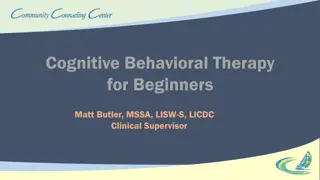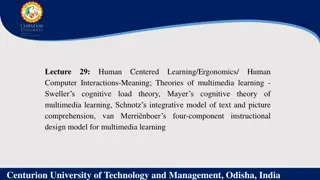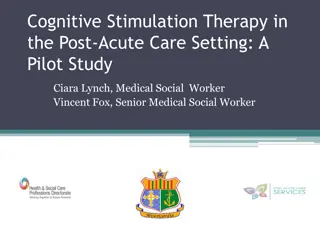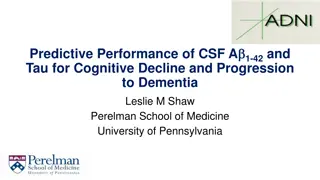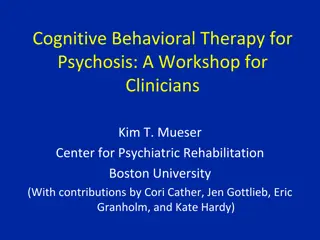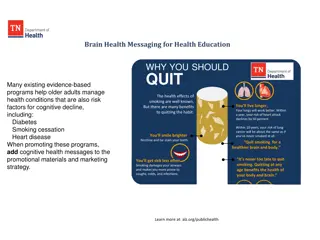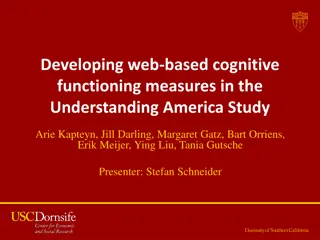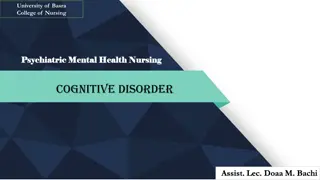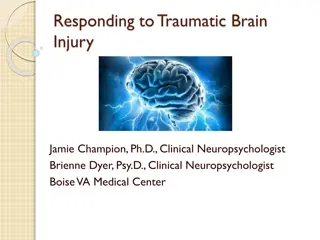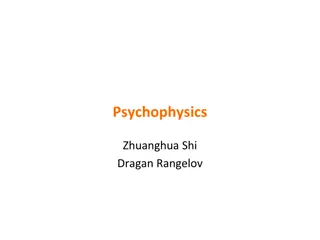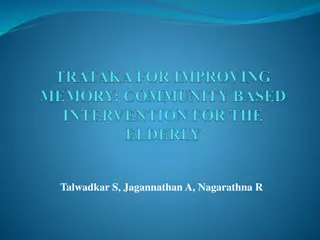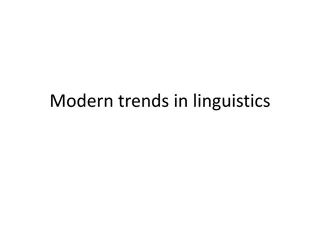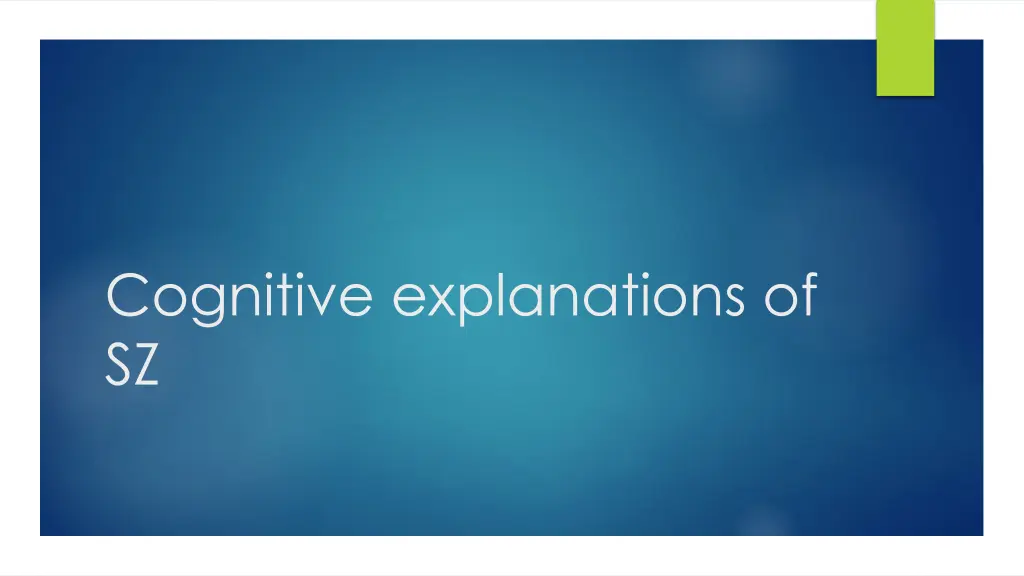
Understanding Schizophrenia: Cognitive Explanations and Dysfunctions
Explore the cognitive explanations and dysfunctions related to schizophrenia, including dysfunctional thought processing, possible cognitive dysfunctions, and how they manifest in symptoms such as disorganized speech and behavior. Learn about cognitive distortions, lack of reality testing, and metarepresentation in individuals with schizophrenia.
Download Presentation

Please find below an Image/Link to download the presentation.
The content on the website is provided AS IS for your information and personal use only. It may not be sold, licensed, or shared on other websites without obtaining consent from the author. If you encounter any issues during the download, it is possible that the publisher has removed the file from their server.
You are allowed to download the files provided on this website for personal or commercial use, subject to the condition that they are used lawfully. All files are the property of their respective owners.
The content on the website is provided AS IS for your information and personal use only. It may not be sold, licensed, or shared on other websites without obtaining consent from the author.
E N D
Presentation Transcript
Complete the Gap fill Review expressed emotion by completing the gaps Sort the sentence(s) into examples of being CRITICAL, HOSTILE and OVER PROTECTIVE Ext. think of your own examples and write these on the page
Cognitive explanations http://www.math.unt.edu/~tam/SelfTests/StroopEffects.html I need 3 people to volunteer please! https://faculty.washington.edu/chudler/java/ready.html
Dysfunctional thought processing This is information processing that is not functioning normally and as a consequence produce undesirable outcomes (i.e. schizophrenia!) As we consider different dysfunctional thought processes try to consider which SYMPTOMS these would relate to.
Possible Cognitive Dysfunctions in SZ Central control suppressing automatic responses while doing something deliberate (STROOP TEST) i.e. not having an internal conversation while talking out loud to someone! Stirling found that SZs took twice as long to name the colours on the stroop test than healthy controls. How does this link to specific symptoms of SZ? This explains disorganised speech and behaviour
Cognitive dysfunctions Read and highlight either paragraph on cognitive explanations of delusions or hallucinations (they are very full of jargon but stick with it!) Now together with someone who read the other come up with a list of SIMILARITIES What cognitive dysfunctions do schizophrenics display?
Other Possible Cognitive dysfunctions Lack of reality testing Recognition of inner thoughts Recognition of events as irrelevant Cognitive distortions
Other Possible Cognitive dysfunctions These can be explained through Metarepresentation the ability to reflect on your thoughts and intentions This in particular explains delusions and hallucinations as they cannot recognise that it is really THEIR OWN thought patterns and intentions Instead they attribute them to someone else!
Cognitive distortions Ways that we think to convince us of something that isn't really true. These inaccurate thoughts are usually used to reinforce irrational or negative thinking or emotions telling ourselves things that sound rational and accurate, but really only serve to reinforce how we already feel/act This can reinforce delusions despite intervention/ therapy
Other Possible Cognitive Dysfunctions Additional notes Hemsley presented a neuro-psychological theory This is NOT in your booklets but is still credit worthy as a cognitive dysfunction and has good evidence linking it to neural correlates
Cognitive explanation Central executive Memory
Cognitive explanation Central Executive Memory
Cognitive explanation As a result they let in too much information This causes them to be overwhelmed by environmental stimuli It is this which causes them to experience the world differently and also gives rise to their thought disturbance
Hemsley SZ is caused by a breakdown in the relationship between already stored memory and new incoming information
Hemsley Attention STM LTM Schemas are stored here and retrieved to inform us what to pay attention to
Hemsley Additionally internal thoughts are not recognised giving way to auditory hallucinations Attention STM Schemas are not retrieved and so each situation SZ s are subject to sensory overload and may attend to inappropriate elements these are seen as personally relevant i.e. news broadcasts/ others conversations LTM
Evaluation You will be given a statement evaluating Psychological explanations: Decide if it is relating to family dysfunction or cognitive explanations Discuss why this is a strength or limitation Write further elaboration and a So What sentence for each one Time limit of 3 mins per statement
Saving Yourself There has been cutbacks at the university research department. Most of you will have to go. The university will only consider the most valuable members of the department to keep on You have 10 mins to prepare an argument as to why the university should keep you
Characters Gottesman Bateson Linzen Frith Hemsley Brown and Birley Tienari Shaffer (neural correlates) Joseph Berger Kolafi
Quiz Revise your notes We will now have a quiz on all the content we have covered so far in booklet 2
Test Answer the following question: Outline and evaluate biological explanations of schizophrenia (8+16 marks)
Myer-Linderberg found reduced activity in the prefrontal cortex of schizophrenics when they did a task involving working memory. This shows that there is a link between dysfunctional information processing and schizophrenia.
High expressed emotion amongst families could be a symptom rather than a cause This implies that certain family settings are a consequence of living with a schizophrenic rather than the factor that helped the schizophrenia to originate in the first place.
Berger (1965) found that schizophrenics reported a higher recall of double bind statements by their mothers than non-schizophrenics. This implies that it was the exposure to mixed messages from a specific family member that caused the schizophrenia to occur in their children.
This implies that parents are responsible for the problems of their children. This is an issue for the explanation as it could cause psychological harm to parents of schizophrenics as it blames them for their child s illness something that could undermine their ability to help them.
Kalafi and Torabi found that the negative emotional climate in Iranian culture (over-protective mothers and rejecting fathers) led to a higher relapse rate in schizophrenia. This suggests that schizophrenia can be linked to aspects of the family environment as over-protectiveness is a characteristic of a schizophrenogenic maternal figure whilst a negative emotional climate would link to one that is high in expressed emotion.
Information about childhood experiences was gathered after the development of symptoms and a diagnosis of schizophrenia. This suggests that patients disturbed cognitions may distort the validity of the information patients provide when recalling how their parents treated them as children.
Dysfunctional thinking could be a consequence of schizophrenia rather than a cause. This is a problem for the explanation as it implies that something else causes the schizophrenia in the first place, and it is this factor that then leads to distortions in cognition.

